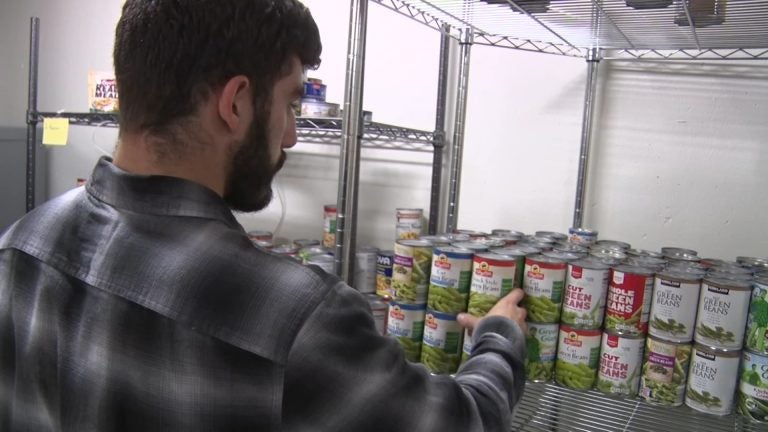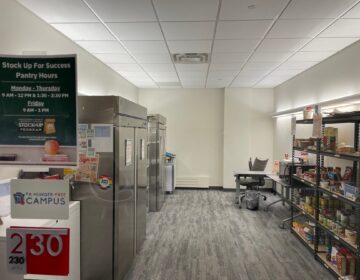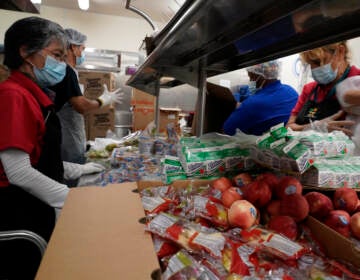Hunger on New Jersey campuses is more common than you may think
Efforts are increasing to help students who aren’t getting enough nutritious food; by one estimate, as many as one-third suffer from ‘food insecurity’

Sean Hardy, a senior at Montclair State University visits the food pantry there. (NJTV News)
This article originally appeared on NJ Spotlight.
–
Every college student is on a budget, but for one Bergen Community College student, money is especially tight. The 22-year-old Hackensack man lives on his own, renting a room for $545 a month and taking a bus to campus. A full-time course load and a work-study program at BCC leave him without time for additional employment, so he stretches his limited financial resources as best he can. The student, who did not wish to be identified, works about 20 hours a week in the work-study program for $10 an hour.
A food pantry run by the college and Hunger Free New Jersey, an anti-hunger advocacy organization, has been a lifeline for the mass communications major, and recently, that lifeline has reached a little longer. In October, the Bergen County Board of Social Services came to the Paramus-based school with Supplemental Nutrition Assistance Program outreach and assistance and helped him apply for SNAP, formerly known as food stamps.
Soon, his Electronic Benefits Transfer card will provide $190 a month that he can spend on food, such as refrigerated goods that are unavailable at the food pantry.
“I’m very grateful for the help,” says the student, who plans to continue his education at a four-year college after an anticipated graduation from BCC this month. “Having a way to afford fresh fruits and vegetables gives me one less thing to worry about.” One less worry will help keep him in the classroom.
The BCC student’s experiences are more common than many realize. Food insecurity — lack of access to affordable, nutritious food — affects more than one-third of college students, according to Hunger Free New Jersey, with some estimates even higher. With about 240,200 full-time undergraduates in the state, that means about 80,000 could be going to classes hungry. If the calculation were applied to the state’s total student population of 413,000, that number would rise to 138,000.
Colleges across New Jersey are stepping up efforts to ease hunger among students, aided by educational and community nonprofit organizations, a $1 million state grant program and new state SNAP rules designed to make more students eligible for the benefits. These redoubled efforts come at a time when nationally, the needle has moved slightly on hunger — 11.1% of U.S. households were food-insecure in 2018 compared with 11.8% in 2017, according to the U.S. Department of Agriculture.
Several factors contribute to food insecurity among college students. A 2018 U.S. Government Accountability Office report on campus food insecurity noted escalating college costs have outpaced federal and state student aid, with more students and families taking on college costs themselves. Meanwhile, more low-income students (those with a household income at or below 130% of the federal poverty line) are attending college — up from 28% in 1996 to 39% in 2016. And, the average college student in 2016, according to the GAO, was not the traditional high school-to-college teen dependent on their parents, but instead 26 years old, most likely working at least part-time and possibly a parent.
Hungry students often have other struggles
Hungry students come from all walks of life, says Assemblywoman Pamela Lampitt (D-Camden), who has a unique vantage point as both a legislator and general manager for conference and dining services at the University of Pennsylvania. They include financial aid recipients, middle-income kids choosing the cheapest meal plan, graduate students on small stipends and a wary population of undocumented immigrants. Not only are these students hungry, Lampitt says, they often struggle with housing, child care and transportation issues.
“It’s not enough to provide books and a classroom,” says Lampitt. “College students need nutritious food and a warm place to sleep; otherwise, their focus is taken off the path to success.”
Or, as Jake Farbman explains it, they need “assistance with what happens when life gets in the way.” As executive director of the Center for Student Success at the New Jersey Council of County Colleges, he understands the challenges today’s students face — especially the low-income and nontraditional enrollees at community colleges. One of the council’s “Vision 2028” initiatives is to connect students with social service supports — whether through the state, county welfare agencies or community and faith-based organizations to address not only hunger but mental health issues, housing, substance abuse and other common barriers to educational success. Farbman is also keenly aware of the role community colleges have in helping the state reach an ambitious target: increase the percentage of New Jerseyans with some type of post-high school credential from today’s 53% to 65% by 2025.
“Colleges are looking at students in a more holistic way,” he says. “Many students are facing significant barriers to completing a credentialed program or a degree, such as hunger or the inability to find reliable child care. We hear their stories, but we also want to understand their challenges through data, which is why New Jersey county colleges participated in the Hope Center’s #Real College survey, a very well-regarded national assessment of basic needs security among college students. The survey results, expected early next year, will help us know exactly what food insecurity looks like on New Jersey county college campuses.”
Legislation to change the campus landscape
Last May, Gov. Phil Murphy signed a package of 10 hunger-related bills championed by Assembly Speaker Craig Coughlin (D-Middlesex) into law; one of them aims to improve the ways public New Jersey institutions of higher education address student food insecurity. Under the Hunger-Free Campus Grant Program, qualifying schools have until Jan. 31, 2020, to apply for one-time awards ranging from $40,000 to $100,000 to improve existing hunger-relief programs. The grant criteria include having a campus hunger task force, food pantry or other “stigma-free” way for students to receive food, and a meal plan “swipe” credit-sharing program or free meal vouchers. The grant monies can be used to purchase such items as food, refrigerators, gift cards and microwaves, and fund programs or events.
One requirement of the grant program is to conduct a student survey on hunger and report results to the state and the respective school. As with the Hope Center survey, this questionnaire will provide New Jersey-specific data on-campus food insecurity. The survey uses 18 questions from the U.S. Department of Agriculture’s food insecurity index, such as: “In the last 30 days, were you ever hungry but didn’t eat because there wasn’t enough money for food?”
The grant program also focuses on sustainable solutions, namely, enrolling eligible college students in the federally funded, state-administered SNAP. “Food pantries are very important, but they’re not a long-term solution. It can vary from day to day what’s on the shelves,” says Adele LaTourette, director of Hunger Free New Jersey. “SNAP offers greater access to fresh and refrigerated foods, as well as a broader choice of what to eat than many food pantries. For those who qualify, it’s the first line of defense against hunger.”
The keyword is eligible, as college student status alone isn’t enough to qualify for SNAP. In addition to low income, college students must meet at least one other criterion, such as working 20 hours or more a week at a paying job, participating in a federal work-study program or being responsible for a dependent under age 6. In 2018, the Murphy administration changed SNAP rules to expand eligibility to students enrolled in career and technical education programs at community colleges.
The new rule could potentially lead to the enrollment of thousands of more college students in SNAP, which anti-hunger advocates say is currently underutilized by them. According to the GAO analysis, about 57% of potentially SNAP-eligible college students did not participate in the program, and it recommended that the USDA’s Food and Nutrition Service provide clearer eligibility and enrollment information on its SNAP website.
“SNAP is not on many students’ radar, so we and many other anti-hunger partners are working to build awareness and help students understand the enrollment process and the documentation they’ll need to provide,” says Lisa Pitz, outreach director for Hunger Free New Jersey. The state, too, has been putting out the word on SNAP. For example, during NJ SNAP Awareness Week in November, Human Services Commissioner Carole Johnson was interviewed on Stockton University’s radio station about the program and how college students can apply.
Food pantries: an important resource
While food pantries aren’t a long-term solution to campus hunger, they are an important resource that’s increasingly found on New Jersey’s four-year and two-year college campuses. Many are open a few days a week, and in addition to non-perishable food, some offer toiletries and provide students with information about social support services; a few also offer fresh produce. On #GivingTuesday, for example, the Rutgers University Foundation once again encouraged financial support for food banks on all three campuses; the 2018 drive supported meals and services for more than 1,300 students.
At Brookdale Community College’s main campus in Lincroft, orange buckets are emblematic of the school’s efforts to ease student hunger. When an employee noticed snacks left out for anyone’s consumption were quickly taken, a more deliberate approach developed: strategic placement of orange buckets (orange is the color symbolizing hunger) stocked with snack bags and bottles of water — first in well-traveled areas on the main campus, such as the library and student life center. The “take what you need, leave what you can” approach was so well received and needed that bucket placement soon expanded to the Monmouth County college’s other campuses, said Yesenia Madas, the school’s associate vice president of student affairs.
Today, what began in fall 2016 as a simple way for students to access free food at Brookdale has a name — Helping Hands — and a physical location. The Helping Hands Lounge opened in September, partially funded by a state Community College Opportunity grant; in addition to pantry staples, it has a refrigerator and a microwave. Additionally, the Fulfill mobile food pantry has made three visits to campus this semester. For Thanksgiving, says Madas, the school anticipated giving students between 50 and 60 gift baskets donated by a local religious organization; it ended up distributing more than 100.
“College students have many needs beyond the classroom,” says Madas, “and if they leave school before completing a certificate or degree, it’s not necessarily because of academics. It could be there’s not enough food at home, so a student must work more hours and not be able to continue his or her studies. If there’s a way we can ease these barriers so students can better meet their educational goals, we will try.” A social worker comes to Brookdale twice a week to assist students with social services such as SNAP applications, with about 30 students helped in the fall semester.
In November, Madas was a panelist at the New Jersey Council of County Colleges’ Vision 2028 conference that brought together about 200 public, social service and nonprofit representatives, including the Community Food Bank of New Jersey, the Anti-Poverty Network of New Jersey, Hunger-Free New Jersey, and the state departments of Labor and Higher Education. The purpose was to share best practices in meeting college students’ nonacademic needs, with interest shown in reestablishing a New Jersey chapter of the National College and University Food Bank Alliance.
Imani Johnson, a Middlesex County College student who aspires to be a dietician and serves on its Task Force for Hunger Relief, was another panelist.
“I’ve been very, very fortunate to always have food at every meal,” she says, “but some of my closest friends in the same town, school and classes were not. It’s very sad to me, knowing the food service as I do, that there’s so much wasted food on one side and so much need on the other. Of all the volunteering I do, this is the most meaningful to me.
“There are students in the public school system who, from kindergarten through 12th grade, received a free or reduced lunch. Now, they go to college at 17 or 18 and that support is gone, and college food is more expensive than the high school cafeteria. They’re in class or on campus several hours a day, and often have to choose between paying for tuition and textbooks than meals. So, they go without.”
WHYY is your source for fact-based, in-depth journalism and information. As a nonprofit organization, we rely on financial support from readers like you. Please give today.




